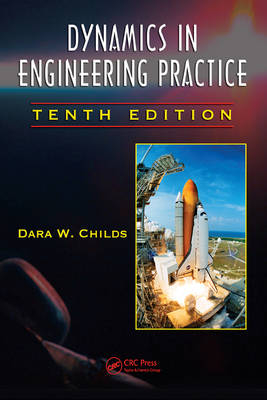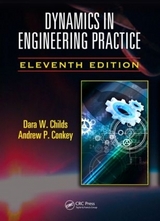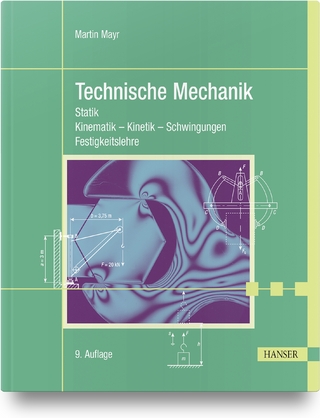
Dynamics in Engineering Practice, Tenth Edition
Crc Press Inc (Verlag)
978-1-4398-3125-0 (ISBN)
- Titel erscheint in neuer Auflage
- Artikel merken
Most undergraduate books for engineering dynamics exhibit a continuing disconnect from either the requirements of subsequent coursework or the practice of dynamics in an engineering career. Dynamics in Engineering Practice, Tenth Edition counters this dated viewpoint with a modern approach that is better suited to today’s engineering study and practice. Written by a renowned teacher, researcher, and professional consultant in applied dynamics, this book represents a revolutionary approach to modern engineering dynamics analysis—one you can assimilate quickly and easily to get immediate results.
Real-World Guidance to Reconnect Principles and Practice
The book begins by establishing the premise that most "dynamics engineers" are developing and analyzing models to predict motion, and that the subject of differential equations is the natural language for dynamics. From this starting point, the author immediately presents mechanical vibration examples to demonstrate applications of f=ma and work-energy principles, and he includes multiple "real-world" 1DOF and MDOF planar dynamics examples, which are completely worked out.
Learn Exactly How an Engineer REALLY Solves Engineering Modeling and Analysis Problems
Dynamics describes the continuous evolution of motion, yet most textbooks approach the field as a series of ``snapshots,’’ posing questions about variables at specific idealized positions or orientations. Advancing the idea that a practicing dynamics engineer’s central role is to develop and analyze models, this book:
Presents an ordered and logical set of procedures and alternatives for developing models and solutions for any planar dynamic or vibration example
Uses repeated examples to demonstrate how models are analyzed via current computer approaches
Includes the latest MATLAB® updates and other proven methods for modeling and analysis
Helps readers ask the right questions to get the most out of problems and optimize modeling of general dynamic systems.
Based on the author’s more than 40 years of experience teaching and developing courses in dynamics, this book teaches general skills—where effectiveness can be demonstrated for a wide range of problems, rather than a collection of problem-specific "tricks." An essential resource at both the academic and professional levels, this text will be indispensable to both students and working engineers analyzing real dynamic systems.
Dara W. Childs is the Leland T. Jordan Chaired Professor in the Mechanical Engineering Department at Texas A&M University. Since 1984, he has directed the school’s Turbomachinery Laboratory. He has a distinguished research career, including work on many research and consulting projects related to dynamics of rotating machinery. He predicted a costly rotordynamic instability problem with the High Pressure Fuel Turbopump of the Space Shuttle Main Engine prior to tests and was instrumental in resolving the problem.
Introduction and Fundamentals
A Short History of Dynamics
Units
Planar Kinematics of Particles
Motion in a Straight Line
Particle Motion in a Plane: Cartesian Coordinates
Coordinate Transformations: Relationships between Components of a Vector in Two Coordinate Systems
Particle Motion in a Plane: Polar Coordinates
Particle Motion in a Plane: Normal-Tangential (Path) Coordinates
Moving between Cartesian, Polar, and Path-Coordinate Definitions for Velocity and Acceleration Components
Time-Derivative Relationships in Two Coordinate Systems
Velocity and Acceleration Relationships in Two Cartesian Coordinate Systems
Relative Position, Velocity, and Acceleration Vectors between Two Points in the Same Coordinate System
Planar Kinetics of Particles
Nomenclature
Differential Equations of Motion for a Particle Moving in a Straight Line: An Introduction to Physical Modeling
More Motion in a Straight Line: Degrees of Freedom and Equations of Kinematic Constraints
Motion in a Plane: Equations of Motion and Forces of Constraint
Particle Kinetics Examples with More Than One Degree of Freedom
Work–Energy Applications for One-Degree-of-Freedom Problems in Plane Motion
Linear-Momentum Applications in Plane Motion
Moment of Momentum
Planar Kinematics of Rigid Bodies
Rotation about a Fixed Axis
Velocity and Acceleration Relationships for Two Points in a Rigid Body
Rolling without Slipping
Planar Mechanisms
Planar Kinetics of Rigid Bodies
Nomenclature
Inertia Properties and the Parallel-Axis Formula
Governing Force and Moment Equations for a Rigid Body
Kinetic Energy for Planar Motion of a Rigid Body
Fixed-Axis-Rotation Applications of the Force, Moment, and Energy Equations
Compound-Pendulum Applications
General Applications of Force, Moment, and Energy Equations for Planar Motion of a Rigid Body
Moment of Momentum for Planar Motion
Appendices
Index
| Erscheint lt. Verlag | 2.9.2010 |
|---|---|
| Zusatzinfo | 1000-2000 equations - PPI 606; 650 Illustrations, black and white |
| Verlagsort | Bosa Roca |
| Sprache | englisch |
| Maße | 219 x 276 mm |
| Gewicht | 1157 g |
| Themenwelt | Naturwissenschaften ► Physik / Astronomie ► Mechanik |
| Technik ► Maschinenbau | |
| ISBN-10 | 1-4398-3125-4 / 1439831254 |
| ISBN-13 | 978-1-4398-3125-0 / 9781439831250 |
| Zustand | Neuware |
| Haben Sie eine Frage zum Produkt? |
aus dem Bereich



